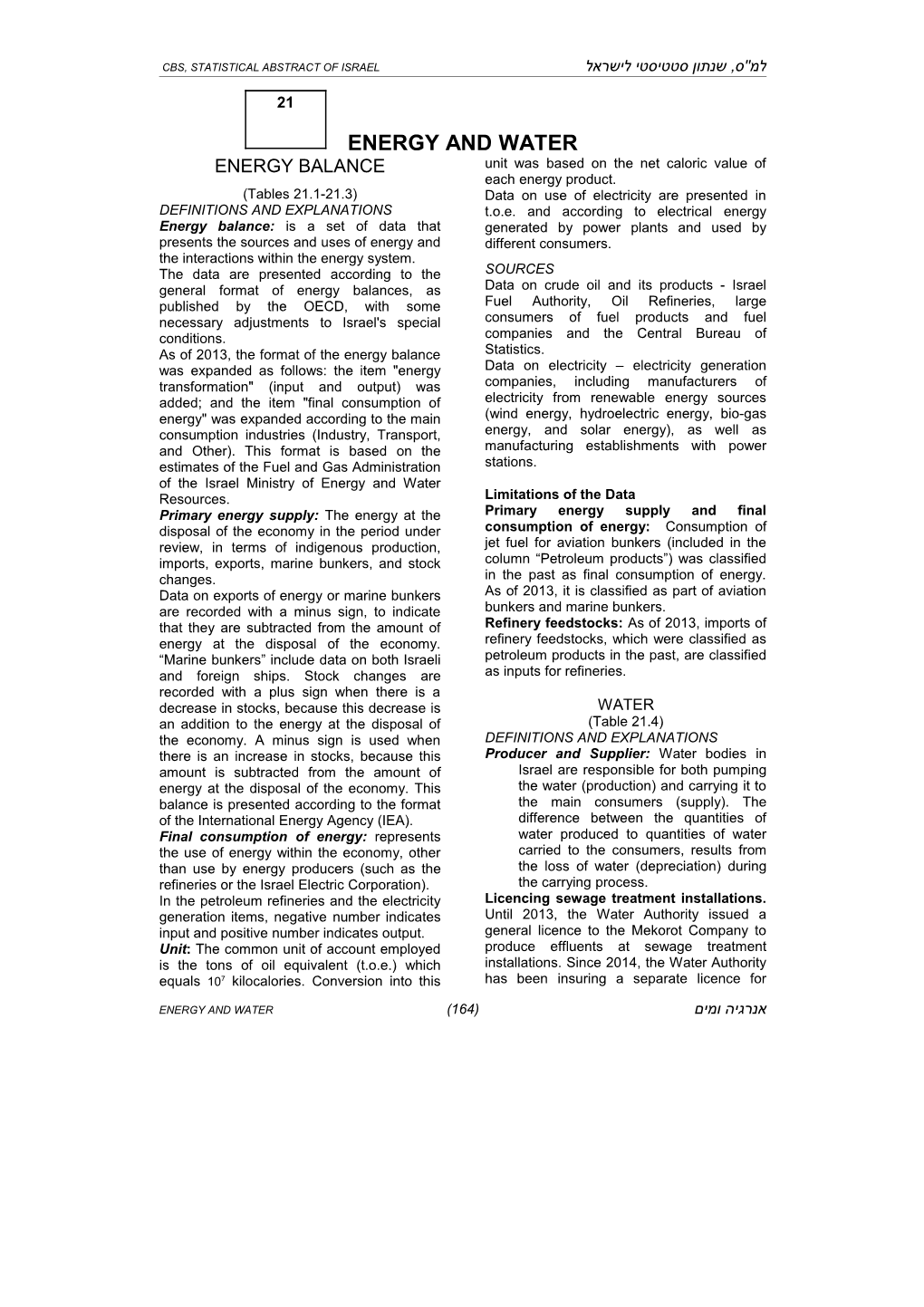למ''ס, שנתון סטטיסטי לישראל CBS, STATISTICAL ABSTRACT OF ISRAEL
ENERGY AND WATER
אנרגיה ומים(1)ENERGY AND WATER
למ''ס, שנתון סטטיסטי לישראל CBS, STATISTICAL ABSTRACT OF ISRAEL
ENERGY BALANCE
(Tables 21.1-21.3)
DEFINITIONS AND EXPLANATIONS
Energy balance: is a set of data that presents the sources and uses of energy and the interactions within the energy system.
The data are presented according to the general format of energy balances, as published by the OECD, with some necessary adjustments to Israel's special conditions.
As of 2013, the format of the energy balance was expanded as follows: the item "energy transformation" (input and output) was added; and the item "final consumption of energy" was expanded according to the main consumption industries (Industry, Transport, and Other). This format is based on the estimates of the Fuel and Gas Administration of the Israel Ministry of Energy and Water Resources.
Primary energy supply: The energy at the disposal of the economy in the period under review, in terms of indigenous production, imports, exports, marine bunkers, and stock changes.
Data on exports of energy or marine bunkers are recorded with a minus sign, to indicate that they are subtracted from the amount of energy at the disposal of the economy. “Marine bunkers” include data on both Israeli and foreign ships. Stock changes are recorded with a plus sign when there is a decrease in stocks, because this decrease is an addition to the energy at the disposal of the economy. A minus sign is used when there is an increase in stocks, because this amount is subtracted from the amount of energy at the disposal of the economy. This balance is presented according to the format of the International Energy Agency (IEA).
Final consumption of energy:represents the use of energy within the economy, other than use by energy producers (such as the refineries or the Israel Electric Corporation).
In the petroleum refineries and the electricity generation items, negative number indicates input and positive number indicates output.
Unit: The common unit of account employed is the tonsof oil equivalent (t.o.e.) which equals 107 kilocalories. Conversion into this unit was based on the net caloric value of each energy product.
Data on use of electricity are presented in t.o.e. and according to electrical energy generated by power plants and used by different consumers.
SOURCES
Data on crude oil and its products - Israel Fuel Authority, Oil Refineries, large consumers of fuel products and fuel companies and the Central Bureau of Statistics.
Data on electricity – electricity generation companies, including manufacturers of electricity from renewable energy sources (wind energy, hydroelectric energy, bio-gas energy, and solar energy), as well as manufacturing establishments with power stations.
Limitations of the Data
Primary energy supply and final consumption of energy: Consumption of jet fuel for aviation bunkers (included in the column “Petroleum products”) was classified in the past as final consumption of energy. As of 2013, it is classified as part of aviation bunkers and marine bunkers.
Refinery feedstocks: As of 2013, imports of refinery feedstocks, which were classified as petroleum products in the past, are classified as inputs for refineries.
WATER
(Table 21.4)
DEFINITIONS AND EXPLANATIONS
Producer and Supplier:Water bodies in Israel are responsible for both pumping the water (production) and carrying it to the main consumers (supply). The difference between the quantities of water produced to quantities of water carried to the consumers, results from the loss of water (depreciation) during the carrying process.
Licencing sewage treatment installations. Until 2013, the Water Authority issued a general licence to the Mekorot Company to produce effluents at sewage treatment installations. Since 2014, the Water Authority has been insuring a separate licence for production of effluents to each sewage treatment installation. Therefore, the classification of sewage treatment installations has been reclassified as “other suppliers”.
Classification by use (agricultural, industrial, own consumption). The classification was made by the Water Authority, and is not based on the Standard Classification of All Economic Activities 2011 published by the CBS.
Shafdan: The Dan Region Reclamation Project, see Introduction to Chapter 27 - Environment.
SOURCES
The general water consumption data are obtained from the Water Authority which prepares statistical summaries from monthly returns submitted by all consumers.
Since January 1989, quantities of water are summed according to calendar years (January-December).
אנרגיה ומים(1)ENERGY AND WATER
למ''ס, שנתון סטטיסטי לישראל CBS, STATISTICAL ABSTRACT OF ISRAEL
SELECTED PUBLICATIONS
CURRENT BRIEFINGS IN STATISTICS
16, 2006Energy in Israel, 2005 (Internet only)
אנרגיה ומים(1)ENERGY AND WATER
